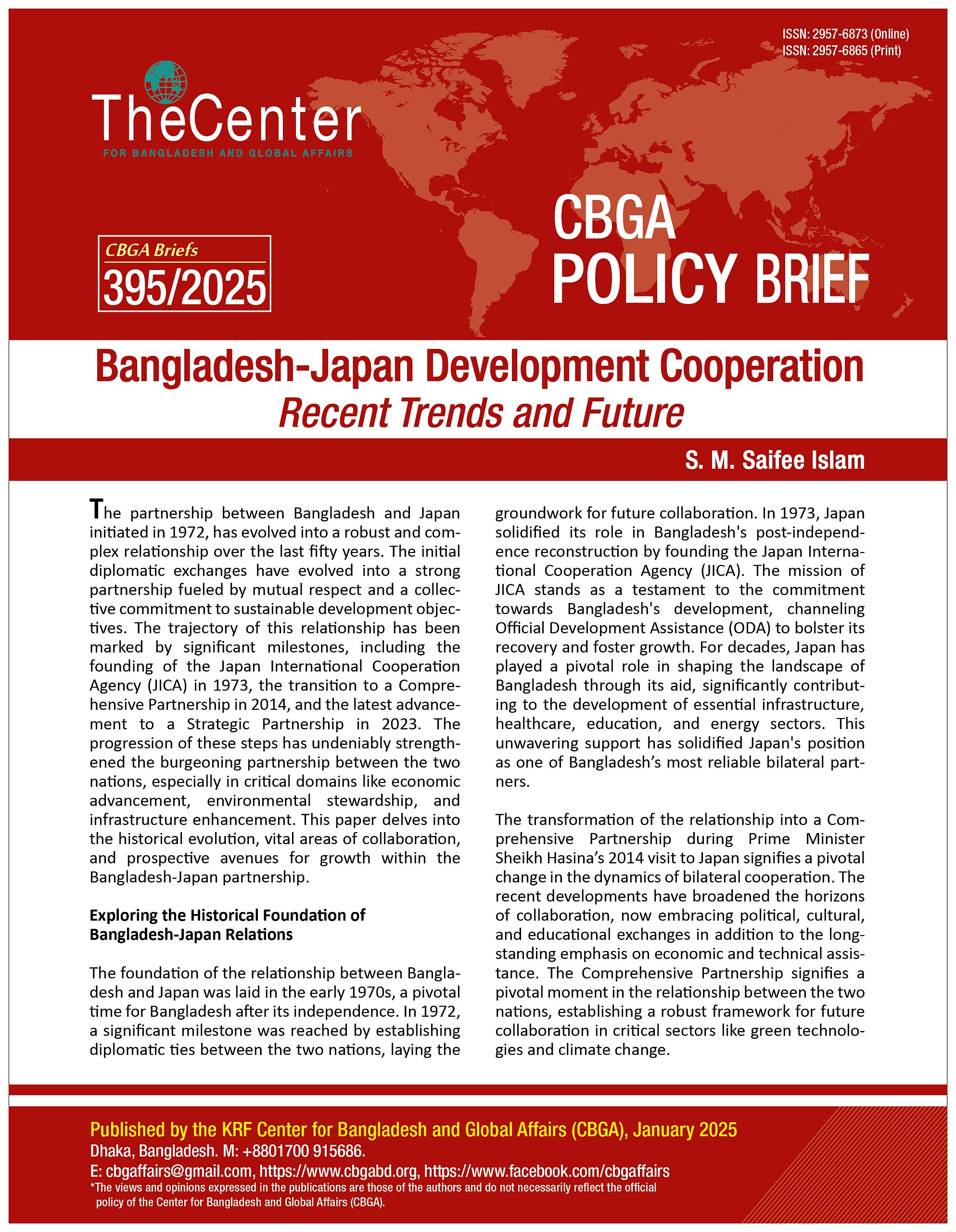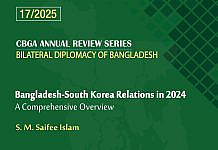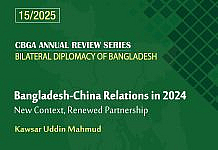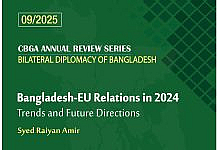
The partnership between Bangladesh and Japan initiated in 1972, has evolved into a robust and complex relationship over the last fifty years. The initial diplomatic exchanges have evolved into a strong partnership fueled by mutual respect and a collective commitment to sustainable development objectives. The trajectory of this relationship has been marked by significant milestones, including the founding of the Japan International Cooperation Agency (JICA) in 1973, the transition to a Comprehensive Partnership in 2014, and the latest advancement to a Strategic Partnership in 2023. The progression of these steps has undeniably strengthened the burgeoning partnership between the two nations, especially in critical domains like economic advancement, environmental stewardship, and infrastructure enhancement. This paper delves into the historical evolution, vital areas of collaboration, and prospective avenues for growth within the Bangladesh-Japan partnership.
Exploring the Historical Foundation of Bangladesh-Japan Relations
The foundation of the relationship between Bangladesh and Japan was laid in the early 1970s, a pivotal time for Bangladesh after its independence. In 1972, a significant milestone was reached by establishing diplomatic ties between the two nations, laying the groundwork for future collaboration. In 1973, Japan solidified its role in Bangladesh’s post-independence reconstruction by founding the Japan International Cooperation Agency (JICA). The mission of JICA stands as a testament to the commitment towards Bangladesh’s development, channeling Official Development Assistance (ODA) to bolster its recovery and foster growth. For decades, Japan has played a pivotal role in shaping the landscape of Bangladesh through its aid, significantly contributing to the development of essential infrastructure, healthcare, education, and energy sectors. This unwavering support has solidified Japan’s position as one of Bangladesh’s most reliable bilateral partners.
The transformation of the relationship into a Comprehensive Partnership during Prime Minister Sheikh Hasina’s 2014 visit to Japan signifies a pivotal change in the dynamics of bilateral cooperation. The recent developments have broadened the horizons of collaboration, now embracing political, cultural, and educational exchanges in addition to the longstanding emphasis on economic and technical assistance. The Comprehensive Partnership signifies a pivotal moment in the relationship between the two nations, establishing a robust framework for future collaboration in critical sectors like green technologies and climate change.
In 2023, the relationship between Bangladesh and Japan achieved a significant milestone with its elevation to a Strategic Partnership. This shift signifies a profound dedication from both nations to enhance their relationship across various sectors, such as infrastructure development, technology exchange, environmental stewardship, and enduring economic partnership. With Bangladesh on the brink of graduating from its Least Developed Country (LDC) status by 2026, the Strategic Partnership emerges as a pivotal initiative. This partnership is not merely a formality; it represents a concerted effort to assist Bangladesh in overcoming the multifaceted challenges of economic development and environmental sustainability. Furthermore, it aims to elevate the nation’s role on the global stage, ensuring that it is recognized as a significant player in the international market.
The Significance of Economic Cooperation in Strengthening Partnerships
The partnership between Bangladesh and Japan in economic cooperation is a fundamental pillar of their bilateral relations. For years, Japan has been a pivotal ally in Bangladesh’s development journey, channelling significant financial resources through official development assistance and private investments. Japan’s Official Development Assistance role in Bangladesh cannot be overstated. It has been instrumental in fostering infrastructure development across key sectors such as transportation, energy, healthcare, and education.
List of ODA Loan Projects Under the ‘Comprehensive Partnership’ (2014–2023)
| ODA Loan Package | Total Loan Amount USD (Billion) | Projects |
|
35th (2014) |
1.184 |
1. Matarbari Ultra Super Critical Coal-Fired Power Project (I) 2. Natural Gas Efficiency Project 3. Inclusive City Governance Project 4. Haor Flood Management & Livelihood Improvement Project 5. Small Farmers Agricultural Project |
|
36th (2015) |
1.076 |
1. Foreign Direct Investment Promotion Project 2. Dhaka-Chittagong Main Power Grid Strengthening Project 3. Western Bangladesh Bridge Improvement Project 4. Maternal, Neonatal and Child Health (MNCH) & Health System Improvement Project 5. Urban Building Safety Project |
|
37th (2016) |
1.549 |
1. Cross-Border Road Network Improvement Project 2. Dhaka Mass Rapid Transit Development Project (II) 3. Jamuna Railway Bridge Construction Project (E/S) 4. Matarbari Ultra Super Critical Coal-Fired Power Project (II) 5. Energy Efficiency & Conservation Promotion Financing Project 6. Disaster Risk Management Enhancement Project |
|
38th (2017) |
1.548 |
1. Dhaka Mass Rapid Transit Development Project (Line 1) 2. Kanchpur, Meghna & Gumti 2nd Bridges Construction Project 3. Matarbari Ultra Super Critical Coal-Fired Power Project (III) 4. Hazrat Shahjalal International Airport Expansion Project (I) 5. Small Scale Water Resources Development Project (Phase 2) |
|
39th (2018) |
1.831 |
1. Matarbari Port Development Project 2. Jamuna Railway Bridge Construction Project (I) 3. Dhaka Mass Rapid Transit Development Project (Line 5) 4. Dhaka MRT Development Project (Line 6) 5. Matarbari Ultra Super Critical Coal-Fired Power Project (IV) 6. Health Services Strengthening Project |
|
40th (2019) |
2.5 |
1. Matarbari Port Development Project 2. Matarbari Ultra Super Critical Coal-Fired Power Project (V) 3. Dhaka MRT Development Project (Line 1) 4. Foreign Direct Investment Project (II) 5. Energy Efficiency & Conservation Financing Project (Phase 2) |
|
41st (2020) |
3.2 |
1. Dhaka MRT Development Project (IV) 2. Dhaka MRT Development Project (Line 5) 3. Jamuna Railway Bridge Construction Project 4. Hazrat Shahjalal International Airport Expansion Project (II) 5. Food Value Chain Improvement Project 6. Chattogram-Cox’s Bazar Highway Improvement Project (E/S) |
|
42nd (2021) |
2.823 |
1. Dhaka MRT Development Project (Line 1 – Tranche II) 2. Matarbari Ultra Super Critical Coal-Fired Power Project (Phase 1 – Tranche VI) 3. COVID-19 Crisis Response Emergency Support Loan Phase 2 |
|
43rd (2022) |
2.549 | 1. Southern Chattogram Regional Development Project 2. Dhaka MRT Development Project (Line 5 Northern Route) (II) 3. Matarbari Port Development Project (II) 4. Chattogram-Cox’s Bazar Highway Improvement Project (I) 5. Dual Gauge Double Line (Joydebpur-Ishurdi Section) Project |
|
44th (2023) |
2.537 |
1. Development Policy Loan for Strengthening Public Financial Management 2. Matarbari Ultra Super Critical Coal-Fired Power Project 3. Hazrat Shahjalal International Airport Expansion Project |
In 2023, Japan is a significant player in Bangladesh’s development landscape, with 82 ongoing projects. Among these, 31 are notably supported by Official Development Assistance loans, highlighting a robust commitment to fostering regional growth and collaboration. The scope of these projects is impressive, encompassing critical infrastructure developments like the Jamuna Railway Bridge, the Matarbari Ultra Super Critical Coal-Fired Power Plant, the Dhaka Mass Rapid Transit Development, and the Matarbari Port Development. Each of these initiatives plays a pivotal role in shaping the future of our transportation and energy sectors. The initiatives undertaken have undeniably reshaped Bangladesh’s infrastructure landscape, leading to significant advancements in transportation networks, bolstering the energy supply, and catalyzing economic growth. Japan’s financial contributions, characterized by favorable loan terms like extended repayment periods and low interest rates, have empowered Bangladesh to embark on large-scale infrastructure projects that otherwise would have been challenging to finance.
Japan’s influence is not limited to mere financial contributions; it encompasses a broader commitment through grants and technical assistance in crucial sectors. Japan’s commitment to Bangladesh is evident through its support for the Primary Education Development Programme (PEDP IV), enhancements in waste management systems, and advancements in meteorological systems and water treatment facilities. The significance of these projects cannot be overstated; they are essential for elevating public services, enriching the lives of Bangladeshi citizens, and fostering the nation’s comprehensive development.
The Future of Partnership: New Frontiers in Collaboration
Although longstanding sectors such as infrastructure, energy, and education continue to play a pivotal role in the Bangladesh-Japan partnership, the emerging areas of cooperation have gained significant traction in recent years. Among the challenges we face today, climate change and environmental sustainability stand out as paramount concerns that demand immediate attention and action. Bangladesh stands at a critical juncture as it grapples with the pressing realities of climate change—rising sea levels, increased natural disasters, and the unpredictability of extreme weather events. In this context, Japan’s wealth of knowledge in sustainable technologies and strategies for disaster risk reduction emerges as a crucial asset, offering invaluable support in navigating these formidable challenges.
Japan is supporting Bangladesh’s journey towards a sustainable economy, pledging investments in renewable energy and green technologies that could reshape the nation’s future. Japan’s backing of the Mujib Climate Prosperity Plan—a national strategy designed to enhance Bangladesh’s resilience to climate change—is a significant element of this partnership. Japan has played a crucial role in supporting Bangladesh’s initiatives to reduce greenhouse gas emissions, especially methane reduction. This effort aligns with Bangladesh’s Nationally Determined Contributions (NDC) as the Paris Agreement outlines. Japan’s journey to curb emissions and foster environmental sustainability stands as a crucial example for Bangladesh as it strives to achieve its climate objectives.
Beyond its efforts to combat climate change, Japan has taken significant strides in sharing technologies that pertain to waste management and renewable energy. Adopting these technologies is crucial for Bangladesh as it embarks on its journey towards a greener economy. This initiative aligns seamlessly with the nation’s Vision 2041, a bold plan to elevate Bangladesh into a developed nation by the mid-21st century. Japan’s continued backing in these sectors is a pivotal element for Bangladesh’s aspirations towards sustainable development and environmental stewardship.
The Strategic Partnership: A Forward-Looking Perspective
The recent elevation of Bangladesh-Japan relations to a Strategic Partnership in 2023 marks a pivotal moment in their bilateral ties, underscoring the importance of collaboration and mutual interests between the two nations. The forthcoming phase of collaboration promises to deepen partnerships in critical sectors, including infrastructure development, digitalization, and sustainable practices. As Bangladesh nears its transition from the LDC category, the Strategic Partnership emerges as a pivotal element in sustaining the nation’s growth trajectory and facilitating its integration into the global economy.
The ongoing negotiations for an Economic Partnership Agreement (EPA) between the two countries are pivotal to the Strategic Partnership. The EPA is committed to safeguarding Bangladesh’s preferential access to the Japanese market, a crucial lifeline that must remain intact even as the country transitions out of the LDC category. Granting Bangladesh duty-free access to Japan’s market is essential for the nation’s export-driven economy. This opportunity is not merely beneficial but essential for fostering growth and ensuring the sustainability of Bangladesh’s economic future. The EPA creates significant avenues for Japanese companies to channel their investments into Bangladesh, especially within the burgeoning fields of information technology, manufacturing, and infrastructure. The potential for new job opportunities, economic growth, and technological innovation in Bangladesh is not just a possibility but an imperative that must be embraced. The path forward is clear, and the benefits are undeniable.
Exploring the Potential for Partnership: New Frontiers in Industry
Bangladesh’s partnership with Japan extends beyond conventional economic cooperation, revealing substantial opportunities in burgeoning sectors like information technology, renewable energy, and green technologies. The synergy between Japan’s advanced knowledge and Bangladesh’s expanding workforce capacity opens the door to remarkable innovation and economic growth prospects.
Japan’s ongoing commitment to Bangladesh’s information technology sector, highlighted by the training of 1,000 engineers, exemplifies the collaborative efforts of both nations to forge a robust digital economy. This initiative stands to significantly bolster the capabilities of Bangladesh’s workforce while simultaneously fostering fresh avenues for the growth of the local technology ecosystem. Japan’s backing presents a pivotal opportunity for Bangladesh to fast-track its digital transformation, potentially establishing the nation as a leading center for technology and innovation in South Asia.
Bangladesh and Japan have a significant opportunity to enhance their partnership in the renewable energy sector. Japan possesses a wealth of expertise in clean energy technologies, particularly solar and wind power, positioning it as a valuable ally for Bangladesh in its quest to enhance its renewable energy infrastructure. The necessity of this cooperation cannot be overstated for Bangladesh, as the nation strives to diminish its reliance on fossil fuels and transition towards a more sustainable energy landscape.
The Path Forward: Navigating Challenges and Embracing Opportunities for Future Cooperation
The future of Bangladesh-Japan relations holds great potential, yet both nations must confront the challenges ahead to secure the success of their partnership. The evolving landscape of global trade presents a significant challenge that threatens to disrupt the exchange of goods and services between these two nations. As Bangladesh stands on the brink of graduating from LDC status, it faces a critical juncture that demands a strategic shift in its approach to trade dynamics. The nation must bolster its competitiveness in the global market to navigate the challenges and opportunities that lie ahead.
The current political instability, both within our borders and on the international stage, presents significant hurdles to maintaining stable bilateral cooperation. The evolution of political leadership and the recalibration of government policies will significantly influence the trajectory of collaboration, especially in critical domains like foreign investment and trade agreements.
In the face of these challenges, it is crucial to recognize the myriad opportunities for deepening the ties between Bangladesh and Japan. The rising significance of emerging industries, particularly in information technology and green technologies, underscores the necessity for ongoing collaboration. The intersection of Japan’s technological prowess and Bangladesh’s vibrant, youthful workforce presents a unique opportunity for innovation and economic advancement in both nations. This synergy could pave the way for transformative growth, benefiting the economies involved and setting a precedent for international collaboration in the face of global challenges.
In conclusion, the bond between Bangladesh and Japan has undergone a remarkable transformation since it began in 1972, evolving into a vibrant and complex partnership. The recent elevation to a Strategic Partnership in 2023 marks a pivotal moment for both countries, setting the stage for enhanced collaboration in critical domains, including infrastructure development, digitalization, climate change, and sustainable growth. This development is not merely a formality; it represents a commitment to addressing some of the most pressing challenges of our time through cooperative efforts. The partnership between Bangladesh and Japan stands as a beacon of potential, ripe with opportunities that promise mutual benefit. These two nations can realize their common aspirations for economic prosperity, environmental sustainability, and technological advancement through sustained investment and collaboration.
– S. M. Saifee Islam is a Research Associate at the KRF Center for Bangladesh and Global Affairs (CBGA).







